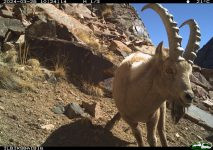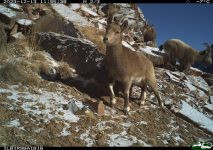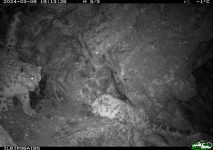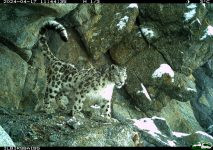
The Ilbirs Foundation has released exclusive images of snow leopards captured by camera traps in the Baiboosun micro-reserve.





 Camera traps and pasture assessments in the Baiboosun micro-reserve were conducted by the Ilbirs Foundation staff with help of volunteers.
Camera traps and pasture assessments in the Baiboosun micro-reserve were conducted by the Ilbirs Foundation staff with help of volunteers.
- During the initial project phase, camera traps captured at least 5 unique individual snow leopards, including a female snow leopard with cubs.
- Additionally, images of Siberian ibex, Pallas’s cat, snowcock, and other inhabitants of the micro-reserve were obtained.
Venue: Baiboosun micro-reserve, Issyk-Kul region, Ton district.
Date: June 8-15, 2024.
The Ilbirs Foundation staff commenced camera trap inspections and summer pasture assessments in the Baiboosun micro-reserve as part of the project “Cores corridors and cats across Central Asia”. This initiative, funded by the National Geographic Society and the SEGRE Foundation, through Conservation X Labs, aims to help restore ecological connectivity between Khan Tengiri National Park and Naryn Reserve. Gleb Sedash, Lead Biologist, Ilbirs Foundation says “The camera trap data is currently being analyzed. While not all camera traps have been reviewed yet, images of at least five snow leopard individuals, including a female snow leopard with cubs, have already been captured in the Baiboosun micro-reserve. Specifically, snow leopards were detected on 5 out of the 11 camera traps positioned between 3,000 and 3,700 meters above sea level. The exact count will be determined once all camera trap data from the area has been analyzed.”
Some of the activities conducted in the frame of the initiative include the study of the biodiversity and ecological condition of the territory, monitor animals, including rare species, and assess the state of summer pastures. This assessment includes analyzing pasture livestock density, vegetation cover, the impact of human activities, distribution of invasive species, and ecological sustainability. These efforts are crucial for biodiversity conservation, including human-wildlife conflict mitigation measures and contribute to developing strategies for sustainable use of natural resources and ecosystem management.
The unique spot patterns of each snow leopard allow for individual identification and tracking of their numbers. Alongside images of snow leopards, the camera traps have also captured images of Siberian ibex, Pallas’s cats, snowcocks, and other species of the micro-reserve camera traps photos.
Field work in the valleys of the Teskei Ala-Too ridge on the Issyk-Kul Lake side has been completed. Camera traps were initially installed in November 2023 in collaboration with rangers from the Baiboosun micro-reserve and volunteers.
Baiboosun is an area spanning 14,000 ha managed by local communities who play a critical role in the conservation of wildlife.
“Thanks to support from the Critical Ecosystem Partnership Fund and the Wildlife Conservation Society, we have trained the rangers in SMART, a technology to strengthen monitoring protection systems. In the frame of the Central Asian Mammals and Climate Adaptation project, we are also working with UNEP and Camp Alatoo on identifying ways of helping both wildlife and people, including the communities arod Baiboosun, increase their resilienceun to climate change, becoming every year more severe.” says Zairbek Kubanychbekov, Director, Ilbirs Foundation.
This year, volunteers Kalygul uulu Tilek and Ulanbek uulu Adilet actively supported the staff of the Ilbirs Foundation during the expedition.The Ilbirs Foundation supports a mentoring system and is committed to supporting these volunteers in their internships, emphasizing their ongoing learning and skill development. The Foundation encourages them to pursue specialized education and aims for their future roles as certified conservation specialists contributing to nature conservation efforts in the Republic of Kyrgyzstan.
In addition to conducting camera trap monitoring, an assessment of the condition of high-mountain summer pastures in the Baiboosun micro-reserve on the Issyk-Kul Lake side was carried out. Assessment sites were established in all major valleys of the region. Livestock graze here year-round: sheep and cows occupy the pastures in autumn and winter, while yaks take their place in summer, exerting continuous pressure on the pastures. This year-round use of summer pastures can lead to their degradation. Moreover, the presence of large yak herds may render the pastures inaccessible to Siberian ibex during winter months.
In this period, wild wildlife is compelled to descend from snow-covered and icy mountain peaks and cliffs to the upper valleys in search of food. The condition of the mountain pastures was evaluated by specialists from the Ilbirs using the methodology developed by the CAMP-Alatoo Foundation.
The Ilbirs Foundation
The Ilbirs Foundation (website link) is a local conservation organization established in 2016. Its mission is to advance the conservation of Kyrgyzstan’s flora and fauna through community engagement and research initiatives.
National Geographic Society
The National Geographic Society (website link) is dedicated to exploration, scientific achievement, education, and compelling stories. In a rapidly evolving world, they have embraced innovation and intentionally expanded their business model, global reach, and efforts in diversity, equity, and inclusion (DEI).
SEGRE foundation
Fondation Segré (website link) is committed to help protect the biodiversity of our planet through the active conservation of threatened species and their habitat and the restoration of degraded ecosystems.
Conservation X Labs
Conservation X Labs (website link) mission is to prevent an impending sixth mass extinction – the first in Earth’s history driven by the actions of a single species: ours. Unlike traditional conservation efforts, Conservation X Labs focuses on leveraging the best technology, the newest innovation, interdisciplinary genius, and the power of the marketplace to boldly confront the biggest problems facing the planet. Though humans have driven this sixth extinction, we know humans have the power to reverse it.
For more information please contact:
Kenje Sultanbaeva,
Communications Manager
Ilbirs Foundation
whatsapp: +996705351583
e-mail: ilbirsf@gmail.com
website: www.ilbirs.org
We are in social networks: